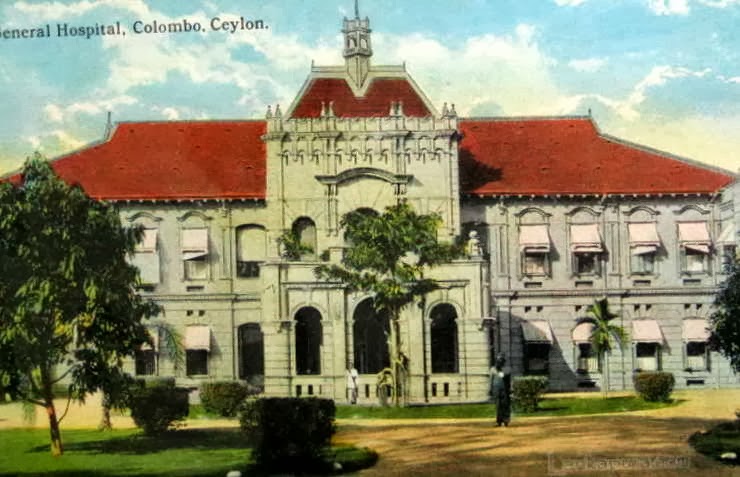
This blog is about the entrants in the year 1960, to the Faculty of Medicine, University of Ceylon, Colombo. The email address for communications is, 1960batch@gmail.com. Please BOOKMARK this page for easier access later.Photo is the entrance porch of the old General Hospital, Colombo, still in existence. Please use the search box below to look for your requirement.
Saturday, April 9, 2016
Pedigree of the present Archbishop of Canterbury
http://www.dailymail.co.uk/news/article-3530902/This-comes-complete-surprise-Archbishop-Canterbury-s-shock-discovering-illegitimate-son-Churchill-s-private-secretary.html
http://www.dailymail.co.uk/news/article-3530902/This-comes-complete-surprise-Archbishop-Canterbury-s-shock-discovering-illegitimate-son-Churchill-s-private-secretary.html
Habits to promote health
Rising spread of sorcery among urbanized folks in present Sri Lanka.
Forwarded for the entertainment value.
Sorcery is dead in Sri Lanka, due to its own failure rate.
Bodhi Poojas, and devale worship survives in spite of the
same failure rate.
But
the tamasha value is high with richer people spending lakhs per event. A
business! Getting bigger.
Good if expats can send some money to smash coconuts. Direct
hits on opponents heads is sure sorcery.
jksw
"Gananath Obeyesekere’s study of Seenigama, Munneswaram and
Kahatapitiya shrines found that most of the clients were from the urbanized
classes, rather than from the rural classes."Thousands
also smash coconuts routinely at shrines invoking harm on enemies ---Read on Thanks Philip
In Sri Lanka Sorcery Is Substitute For
Pre-Meditated Murder By P.K.Balachandran 25th March 2016 S Indian Statesman
COLOMBO: In Sri
Lanka, sorcery is used as a substitute for premeditated murder and physical
violence, says Princeton University’s Emeritus Professor of Anthropology,
Gananath Obeyesekere.
In
his paper: “ Sorcery, Premeditated Murder and Canalization of Aggression”
revised in 2014,
Obeyesekere says that sorcery helps canalize a person’s murderous intention or
wish to physically harm someone into a non-violent form of aggression which is
thought to be as effective as the actual infliction of death or physical injury
while being less risky and less messy.
This explains the widespread use of sorcery by members of all communities in
Sri Lanka – Sinhalese Buddhist, Hindu and Muslim – though users are
predominantly Sinhalese Buddhist.
The use of sorcery is probably more now than before, because in modern Sri
Lanka, sorcery is no longer a crime equivalent to homicide.
In
the times of the Sinhalese Kings, sorcerers were put to death as murderers.
The
most renowned places for sorcery in the island are Seenigama Devale on the
Western coast, south of Colombo, which is a Buddhist shrine;
the Kali
kovil in Munneswaram in Chilaw, north of Colombo, which is a Hindu shrine;
and
the Kahatapitiya shrine in Gampola, in Central Sri Lanka, which is Muslim
shrine housing the grave of a saint.
Neither the people nor the
shrines discriminate on the basis of religion, with the result, Muslims also
consult sorcerers in Munneswaram’s Kali Kovil or at
Seenigama.
To
the anthropologist, the sorcerer is the equivalent of a “hired killer”. In
fact, sorcerers who recite “poison verses ” are thought to be “deadlier than
actual killers,”
and
are “popular among politicians as a technique for getting rid of their
political enemies,” Obeyesekere says.
Given
the high demand, the sorcerers charge high fees.
Obeyesekere’s study of Seenigama, Munneswaram and Kahatapitiya
shrines found that most of the clients were from the urbanized classes, rather
than from the rural classes. Disputes brought
before the sorcerers were about property and sex rather than land.
And
the targets of sorcery were not kinsmen as in the case of landed people, but
outsiders, indicating the concerns of the emerging petty bourgeoisie.
Though
an ancient practice, sorcery in Sri Lanka seems to have contemporary
relevance.
Subscribe to:
Comments (Atom)